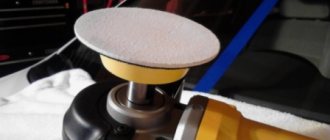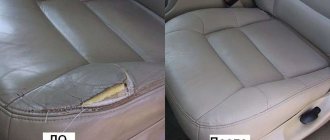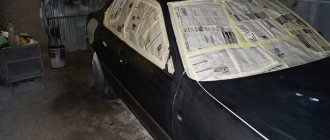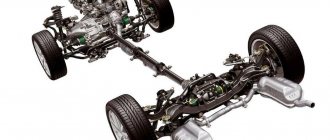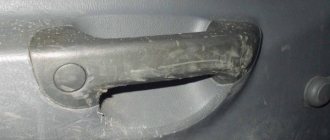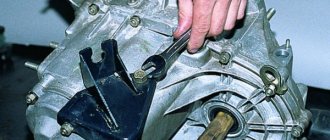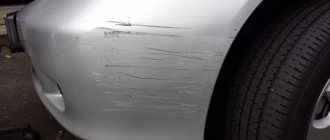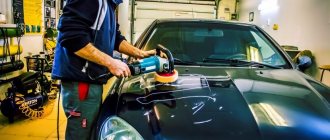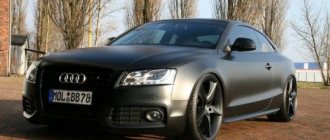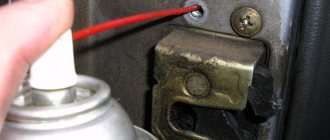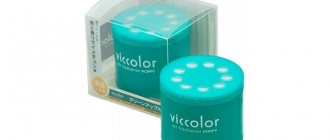Experienced craftsmen assure that the formation of shagreen when painting a car is an inevitable result for beginners. The defect is indeed often encountered in the work of novice painters, but even a professional cannot obtain 100% insurance. By following the rules below, you can easily minimize the risk of the formation of such defects, even when first getting acquainted with car enamel, but to completely get rid of shagreen roughness, ideal conditions and strict adherence to technology will be required. In view of this, the issues of removing shagreen from a car and the acceptable boundaries of the defect remain relevant.
Reasons for the appearance of shagreen
Cynics call shagreen “automobile cellulite,” connoisseurs of romantic comparisons call it “orange peel.” The appearance of the defect fully corresponds to these definitions: the covering ability of the material does not suffer (as well as strength), but the appearance deteriorates beyond recognition. Small bumps form where drops of paint fell to the surface already dried, or where their drying process was noticeably different from the substance surrounding them.
Painting without shagreen skin means knowing the main factors of its formation and systematically preventing them. This can happen for several reasons, but the atmosphere factor influences paint drying more than others. The correct temperature and humidity can easily minimize the risk of defects forming on the surface of the car.
Painting technology without shagreen
The paint drying mechanism is based on the evaporation of the solvent. The solvent dries, the enamel remains. The main difference between solvents is the drying speed, but the evaporation rate is also affected by temperature, humidity and air saturation with solvent vapor. All of these are interconnected parameters; the process can be adjusted by changing the temperature, paint application technology, or diluting the enamel to the desired degree. It seems that it is easier to change the viscosity of the substance, but too liquid paint will lead to smudges on the surface of the car, dry paint can worsen the shagreen. Thus, a defect may appear for the following reasons:
- The paint is prepared (diluted) incorrectly - it is recommended to use the manufacturer’s data, and to increase accuracy, use measuring vessels.
- The required proportions are used, but the solvent is not native (too fast, too slow) - when choosing a solvent, you need to take into account the paint manufacturer’s data, the volume of the room and the quality of ventilation (the data on the solvent packaging is only correct if there is good ventilation).
- High temperature - the temperature in the room reserved for painting the car should not differ much from room temperature (20-23˚C), otherwise you will have to make allowances for this: dilute the paint more, change the way you work with the spray gun (movements, distance to the surface) .
- Uneven compressor operation and air spitting lead to uneven distribution of enamel and the formation of shagreen.
- Wide hole in the spray gun nozzle.
- A large distance to the surface - a certain percentage of the paint may begin to dry in the air if the distance is large; the effect is especially pronounced at high temperatures.
As mentioned above, temperature, ventilation, percentage of solvent and its quality characteristics are interdependent parameters. When faced with this problem for the first time, it is quite difficult to determine the cause, due to the fact that not one parameter changes at once, but several. If an attempt is made to change the viscosity of the paint to eliminate shagreen, then the temperature cannot be adjusted under any circumstances, otherwise the reason will remain unclear if the result is unsuccessful. Painting parameters need to be changed gradually, step by step.
Experienced craftsmen determine the viscosity of enamel by eye. If the temperature is high, then the paint on the car should be thinner. In difficult conditions, the spreadability of the substance is assessed on a test sample: a piece of paper is glued to the wall, and several layers of paint are applied on top. Layers are applied until leakage begins.
Subtleties of work on applying special coatings
To polish a medium-sized car you will need only 3-4 napkins. The product should be applied in a thin layer, without polishing (only the most tarnished surfaces should be rubbed with medium pressure and lightly polished). You can find detailed instructions on how to use liquid glass for cars in the video.
So, to understand how well the work was done, you can use a simple test. Spray the polished car body with clean water. If the polishing is done well, the water on the car collects in large drops and easily flows off the body. Professional car polishing gives a very strong hydrophobic effect to the car body; both water and dirt easily roll off the surface of the car and it stays clean longer. It is easier to wash.
Checking the quality of work
This method is called the “droplet effect” and we consider it the most effective criterion for assessing body polishing. Melted snow mixed with dirt, raindrops, various salts and other abrasive or chemical substances will easily drain from such a coating. If you are thinking about how to choose the most suitable body polishing tool, then we recommend. The angle grinder from this company is a time-tested tool for professional body polishing. But if the drop formation effect is not observed, then this is the first sign that you will have to polish again. And if you run your hand over the body, you can easily feel defects that are difficult for the eye to notice.
Compatibility of solvent and paint
Shagreen can form at any stage of painting: primer, enamel, varnish. At the same time, the final result is equally influenced by errors at all previous stages (the so-called memory effect). It is not always possible to track a defect visually, since it can form under the next layer due to insufficient (incorrect) intermediate drying. In rare cases, the solvent and primer may be incompatible with each other - the issue of choosing a solvent for a varnish coating is an order of magnitude more pressing.
Varnish thinning must be carried out in strict accordance with the manufacturer's instructions. The instructions usually indicate a specific solvent; in the absence of such data, it is best to use products from the same company. In the absence of complete data, solvent 650 can be used with caution, starting with a 2:1 ratio (maximum 3:1).
How to polish a car after painting
Work to eliminate painting defects is carried out in several stages: grinding, polishing, applying a protective coating. Depending on the type of defect (if it is dull, for example), initial grinding is not used. The process begins with deep polishing. In other cases, the order of work does not change.
Grinding
Sanding is done using sandpaper. The wet method involves pre-soaking the skin with 2000 grit abrasiveness for 10 minutes. Then the surface of the body is polished in a circular motion, while the paper is constantly wetted.
Dry sanding can be done using a machine. Use sandpaper to remove possible sagging, making cross-shaped movements with the tool. Use sandpaper with an abrasiveness of 3000-4000 grit.
Tool
Miser pays twice. A good gun costs a painter about 2-4 thousand rubles, but this money is earned by applying paint evenly. Shagreen often forms at the site of spitting, due to the fact that the paint clots at this point on the car differ in density and drying pattern.
The air supply must comply with the requirements of the sprayer, and the nozzle adjustment must comply with the data specified by the paint manufacturer. The spray gun is adjusted after each stage of car painting, since the diameter of the nozzle may change slightly over time. Setting rules are indicated in the instructions for the spray gun.
How to eliminate this defect from a car
It is not easy to eliminate shagreen that appears when painting a car, so it is worth preparing everything for polishing the car in advance. In general, the technology is reminiscent of eliminating chips and other defects on a car. However, each individual case requires its own approach.
In practice, the following methods are usually used:
Removing imperfections by polishing:
- wait until the paint layer hardens properly (about a day after painting);
- matte the problem area of the body using sandpaper (sandpaper) with a fine fraction for fine grinding of metal (grit value about 1500);
- matting technology using abrasive paper can be replaced by washing the top layer;
- apply polishing paste to the damaged area;
- polish the surface with a machine using a soft felt wheel;
- repeat the treatment of the area several times;
- remove traces of paste;
- evaluate the result.
It’s not easy to eliminate shagreen on a car
Removing “orange peel” by local or partial repainting (used in cases of very low quality painting, when polishing work is ineffective):
- wash the enamel layer down to the primer in the damaged area, avoiding any remaining paint;
- determine the quality of the soil, if necessary, washing it down to the metal itself;
- carry out metal processing to prevent the occurrence of defects;
- cover the area with a layer of soil, wash its surface, achieving maximum smoothness;
- after waiting for the soil to completely harden, re-paint the surface to be treated with high-quality paint of the desired color;
- after the enamel has dried, thoroughly polish the paintwork;
- evaluate the result.
In both cases, with an unprofessional approach, there is a possibility of getting noticeable stains on the local painting site against the background of the old coating. You should also be more responsible when choosing a professional to paint your car.
Removing shagreen
Small defects in a car's paintwork appear even under near-ideal operating conditions. Simple roughness can be removed by regular polishing. To get started, you need a bucket of warm, clean water (ideally distilled, without detergents, dirt, etc.) and sandpaper from P1200 (with gentle pressure) or P1500. Final polishing is carried out with numbers P2000, P2500. Final work - polishing pastes 74, 75, or ZM pastes (pure abrasive and transition). The basis for sandpaper is hard rubber (in extreme cases, a block).
For perfect polishing you will need not two, but three abrasive pastes. You need to start using them after slightly matting the surface with sandpaper (P1500, P2000). When working with paper, be sure to use water; excess H2O is removed with rubber. Car polishing is simplified by a machine with variable speed control. Uniformity of movement is important: you cannot linger in one place, otherwise stripes and transitions will appear.
Special abrasives are produced specifically for removing shagreen, such as Trizact wheels. These are abrasives with P2000 and P3000 grit on a soft backing. If you have a lot of experience working with sandpaper, you can use a harder abrasive (up to P1000), but you will have to work hard to remove the marks from its work. If the aesthetic properties of the varnish on a car are not improved even by such abrasives, most likely removing the paintwork and repainting the car cannot be avoided.
Paint, unlike varnish, requires harsher abrasives, but not because of the hardness of the material. The shagreen marks formed on the paint must be removed before applying the varnish, but matting P1500 and P2000 cannot provide the required degree of adhesion - the varnish will begin to peel off even from a slight blow to the car. The necessary adhesion is achieved only when sanding with P1200 grain and coarser, but such materials must be worked with extreme caution.
Removing minor defects in 3M varnish
Shagreen. How to get the finish you want
How to avoid shagreen when painting
Don't skimp on consumables
It may be that polishing coats of varnish that have been seriously damaged may require up to eight disc changes. By changing the polishing material, old and dead varnish layers will not spread over the polished surface. We recommend using liquid glass for car body treatment from Wilson.
This is an excellent manufacturer that produces high-quality materials, including liquid glass. The sequence of surface treatment with a polishing machine does not change. You only need to pay attention to the polishing agent, it should be fine-grained.
